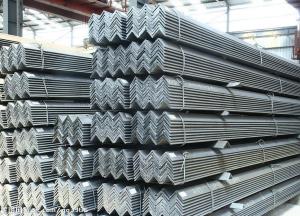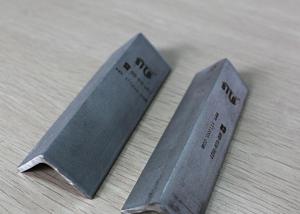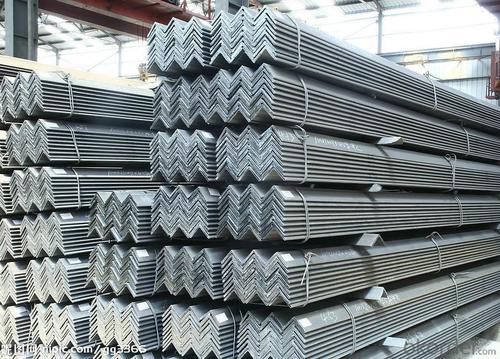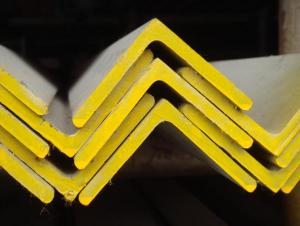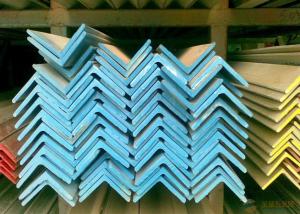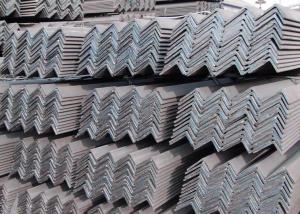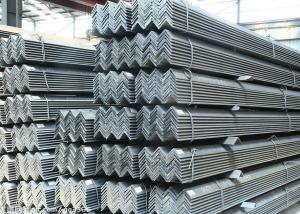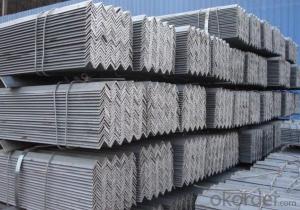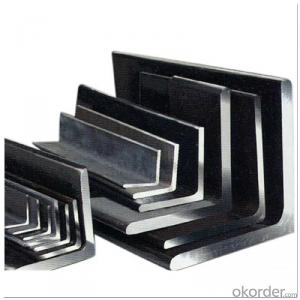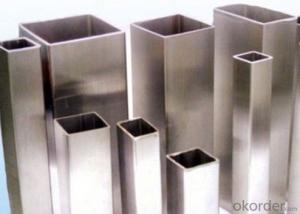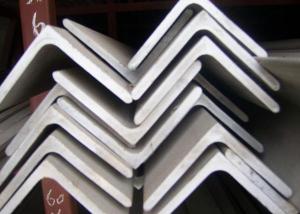Best Quality for Stainless Steel Angles
- Loading Port:
- China Main Port
- Payment Terms:
- TT or LC
- Min Order Qty:
- 1 Ton m.t.
- Supply Capability:
- 2000 Tons Per Month m.t./month
OKorder Service Pledge
OKorder Financial Service
You Might Also Like
Stainless Steel Angles
General Information of Stainless Steel Angles
1. Grade: SS200,300,400 series
2. Size: 25×25×3 mm-100×100×10mm
3. Process: HRAP
4. Length: 2-6m
5. Shape: Equal
6. Delivery: within 20 days
7. MOQ: 1 ton
8. Certificate: ISO 9001:2008, SGS
9. Package: Standard Export Packing, or put into wooden boxes according to your requirement
10. Application: Construction, Marine, Industry and so on.
Specification of Stainless Steel Angles
Name | Stainless Steel Angles | |||||
Standard | ASTM A554, A312, A249, A269 and A270 | |||||
Material Grade | 304,316,201,202, 316L,430 | |||||
Length | 6m or as customers' request | |||||
Tolerance | a) thickness: +/-0. 15mm | |||||
b) Length:+/-4. 5mm - 0mm | ||||||
Surface | 180G, 320G, 400G Satin / Hairline(Matt Finish, Brush, Dull Finish) 400G, 500G, 600G or 800G Mirror finish | |||||
Application | Decoration construction, upholstery, industry instruments | |||||
Test | Squash test, Extended test, Water pressure test, Crystal rot test, Heat treatment, NDT | |||||
Chemical Composition of Material | Composition Material | 201 | 202 | 304 | 316L | 430 |
C | ≤0.15 | ≤0.15 | ≤0.08 | ≤0.08 | ≤0.12 | |
Si | ≤1.00 | ≤1.00 | ≤1.00 | ≤1.00 | ≤1.00 | |
Mn | 5.5-7.5 | 7.5-10 | ≤2.00 | ≤2.00 | ≤1.00 | |
P | ≤0.06 | ≤0.06 | ≤0.045 | ≤0.045 | ≤0.040 | |
S | ≤0.03 | ≤0.03 | ≤0.030 | ≤0.030 | ≤0.030 | |
Cr | 16-18 | 17-19 | 18-20 | 16-18 | 16-18 | |
Ni | 3.5-5.5 | 4-6 | 8-10.5 | 10-14 | ||
Mo | 2.0-3.0 | |||||
Mechanical Property | Material Item | 201 | 202 | 304 | 316L | |
Tensile Strength | ≥535 | ≥520 | ≥520 | ≥520 | ||
Yield Strength | ≥245 | ≥205 | ≥205 | ≥205 | ||
Extension | ≥30% | ≥30% | ≥35% | ≥35% | ||
Hardness (HV) | <253 | <253 | <200 | <200 | ||
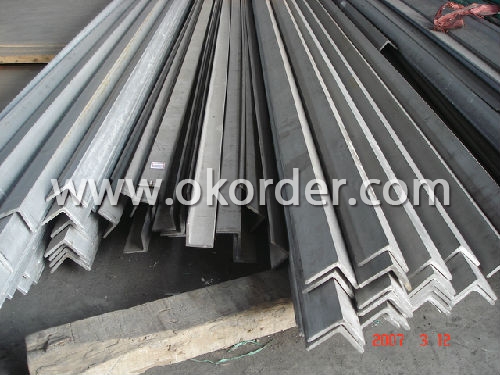
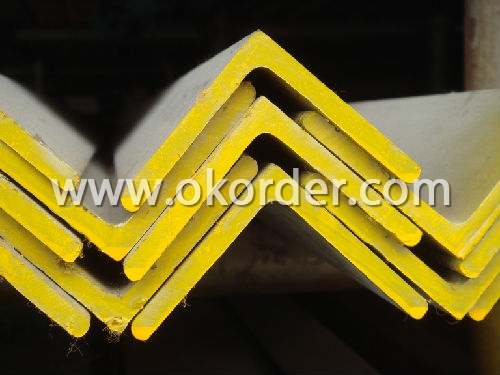
- Q: What is the maximum length of stainless steel angles available?
- The maximum length of stainless steel angles available can vary depending on the manufacturer and supplier. However, in general, stainless steel angles can be found in lengths ranging from 20 feet (6.1 meters) to 40 feet (12.2 meters). These longer lengths are often used in industrial applications where structural support and stability are required. It is important to note that the availability of specific lengths may also depend on the dimensions and thickness of the stainless steel angle being sought. Therefore, it is recommended to consult with the manufacturer or supplier for specific details regarding the maximum length of stainless steel angles they offer.
- Q: Can stainless steel angles be used in the production of electrical systems?
- Yes, stainless steel angles can be used in the production of electrical systems. Stainless steel is known for its high corrosion resistance and durability, making it suitable for various applications, including electrical systems. It provides structural support and stability while also protecting the electrical components from environmental factors.
- Q: Can stainless steel angles be used in the construction of stairs?
- Stainless steel angles are indeed applicable for stair construction. Due to its durability and resistance to corrosion, stainless steel proves to be an ideal option for both indoor and outdoor staircase projects. These angles effectively provide the necessary structural reinforcement and stability to vital staircase parts like handrails, balusters, and treads. By either welding or bolting them together, a robust and enduring staircase design can be achieved. Moreover, stainless steel angles come in a range of finishes and sizes, enabling customization and flexibility in the construction of staircases.
- Q: Can stainless steel angles be used in the production of oil and gas equipment?
- Yes, stainless steel angles can be used in the production of oil and gas equipment. Stainless steel is known for its high strength, corrosion resistance, and thermal stability, making it an ideal material for various applications in the oil and gas industry. Stainless steel angles are commonly used in the fabrication of structural components, supports, frames, and other equipment that require robustness and durability in harsh operating conditions.
- Q: How do you prevent distortion when welding stainless steel angles?
- Several key measures can be taken to prevent distortion when welding stainless steel angles: 1. It is crucial to ensure proper alignment and tight fit-up of the joint between the angles. Any gaps or misalignment can result in distortion during welding. To achieve this, clamps or fixtures can be used to hold the angles in place before welding. 2. Temporary tack welds should be made at regular intervals along the joint before fully welding the angles. Tack welding helps stabilize the workpiece and distributes the heat evenly, reducing the chances of distortion. 3. Controlling the heat input during welding is essential due to stainless steel's lower thermal conductivity. Excessive heat can cause the material to expand and contract, leading to distortion. Using a welding technique like TIG welding, which provides balanced heat input, can minimize distortion. 4. The welding sequence can also affect distortion. Starting from the center and moving towards the ends helps distribute the heat evenly and reduce potential distortion. Alternating between the two sides of the joint balances the thermal effects. 5. Preheating the stainless steel angles before welding reduces the temperature gradient between the joint and the surrounding material, minimizing distortion. Post-weld heat treatment, such as stress relieving, can further reduce distortion by relieving residual stresses. 6. Welding fixtures and jigs provide additional support and control during welding. They help maintain proper alignment and reduce the chances of distortion. 7. Choosing the right welding technique and parameters is crucial. TIG welding is often preferred for stainless steel angles due to its precise control of heat input. Adjusting welding parameters such as speed, current, and shielding gas flow can also minimize distortion. By following these preventive measures, welders can significantly reduce the risk of distortion when welding stainless steel angles, ensuring a high-quality and structurally sound final product.
- Q: How is a stainless steel angle manufactured?
- A stainless steel angle is typically manufactured through a process known as hot rolling, where a stainless steel billet is heated to high temperatures and then passed through a series of rolling mills to shape it into the desired angle profile. This process helps in achieving the required dimensions, smooth surface finish, and improved mechanical properties of the stainless steel angle.
- Q: Are stainless steel angles resistant to chemicals and solvents?
- Yes, stainless steel angles are resistant to chemicals and solvents. Stainless steel is known for its excellent corrosion resistance properties, making it highly resistant to various chemicals and solvents. This resistance is due to the presence of chromium in stainless steel, which forms a thin protective layer on the surface of the material when exposed to oxygen. This layer, known as the passive layer, prevents the steel from reacting with the chemicals or solvents, thereby ensuring its resistance. Stainless steel angles are commonly used in industries where they come into contact with chemicals or solvents, such as the pharmaceutical, chemical, and food processing industries, as they offer long-lasting durability and protection against chemical corrosion.
- Q: Can stainless steel angles be used in food processing industries?
- Yes, stainless steel angles are commonly used in food processing industries. Stainless steel is a popular choice for food processing equipment and structures due to its excellent corrosion resistance properties, hygienic surface, and durability. Stainless steel angles are utilized in various applications such as platforms, frames, supports, and conveyor systems in food processing facilities. The smooth surface of stainless steel angles makes them easy to clean and maintain, which is crucial in maintaining a high level of food safety and preventing the growth of bacteria. Moreover, stainless steel is non-reactive, ensuring that it does not contaminate the food with any harmful substances or affect its taste. Overall, stainless steel angles are a suitable and widely used material in the food processing industry.
- Q: Can stainless steel angles be used in the production of playground structures?
- Yes, stainless steel angles can be used in the production of playground structures. Stainless steel is known for its durability, corrosion resistance, and strength, making it an ideal material for outdoor applications like playground structures. Stainless steel angles can be used to create the structural framework of the playground, providing stability and support. Additionally, stainless steel is easy to clean and maintain, which is crucial for playgrounds where hygiene is important. Overall, stainless steel angles are a suitable choice for playground structures due to their strength, durability, and resistance to corrosion.
- Q: Can stainless steel angles be used as structural supports?
- Indeed, structural supports can utilize stainless steel angles. Stainless steel, being a robust and long-lasting material, possesses the ability to endure substantial burdens and offer stability. In construction and engineering endeavors, stainless steel angles frequently serve as sources of structural support for beams, columns, and additional load-bearing components. Renowned for their impressive strength-to-weight ratio and resistance to corrosion, these angles prove suitable for both indoor and outdoor applications. Furthermore, their versatility is highlighted by the ease with which they can be fabricated and welded to meet precise design specifications, rendering them an adaptable selection for structural support systems.
1. Manufacturer Overview
| Location | Zhejiang, China |
| Year Established | 2010 |
| Annual Output Value | above US$16 million |
| Main Markets | East Asia, Middle East. |
| Company Certifications |
2. Manufacturer Certificates
| a) Certification Name | |
| Range | |
| Reference | |
| Validity Period |
3. Manufacturer Capability
| a) Trade Capacity | |
| Nearest Port | Shanghai |
| Export Percentage | |
| No.of Employees in Trade Department | above 10 people |
| Language Spoken: | English, Chinese |
| b) Factory Information | |
| Factory Size: | about 30000 square meter |
| No. of Production Lines | above 7 |
| Contract Manufacturing | OEM Service Offered |
| Product Price Range | Average |
Send your message to us
Best Quality for Stainless Steel Angles
- Loading Port:
- China Main Port
- Payment Terms:
- TT or LC
- Min Order Qty:
- 1 Ton m.t.
- Supply Capability:
- 2000 Tons Per Month m.t./month
OKorder Service Pledge
OKorder Financial Service
Similar products
Hot products
Hot Searches
Related keywords
